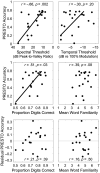Forward Digit Span and Word Familiarity Do Not Correlate With Differences in Speech Recognition in Individuals With Cochlear Implants After Accounting for Auditory Resolution
- PMID: 34251908
- PMCID: PMC8740688
- DOI: 10.1044/2021_JSLHR-20-00574
Forward Digit Span and Word Familiarity Do Not Correlate With Differences in Speech Recognition in Individuals With Cochlear Implants After Accounting for Auditory Resolution
Abstract
Purpose In individuals with cochlear implants, speech recognition is not associated with tests of working memory that primarily reflect storage, such as forward digit span. In contrast, our previous work found that vocoded speech recognition in individuals with normal hearing was correlated with performance on a forward digit span task. A possible explanation for this difference across groups is that variability in auditory resolution across individuals with cochlear implants could conceal the true relationship between speech and memory tasks. Here, our goal was to determine if performance on forward digit span and speech recognition tasks are correlated in individuals with cochlear implants after controlling for individual differences in auditory resolution. Method We measured sentence recognition ability in 20 individuals with cochlear implants with Perceptually Robust English Sentence Test Open-set sentences. Spectral and temporal modulation detection tasks were used to assess individual differences in auditory resolution, auditory forward digit span was used to assess working memory storage, and self-reported word familiarity was used to assess vocabulary. Results Individual differences in speech recognition were predicted by spectral and temporal resolution. A correlation was found between forward digit span and speech recognition, but this correlation was not significant after controlling for spectral and temporal resolution. No relationship was found between word familiarity and speech recognition. Forward digit span performance was not associated with individual differences in auditory resolution. Conclusions Our findings support the idea that sentence recognition in individuals with cochlear implants is primarily limited by individual differences in working memory processing, not storage. Studies examining the relationship between speech and memory should control for individual differences in auditory resolution.
Figures



References
-
- Acheson, D. J. , & Macdonald, M. C. (2009). Twisting tongues and memories: Explorations of the relationship between language production and verbal working memory. Journal of Memory and Language, 60(3), 329–350. https://doi.org/10.1016/j.jml.2008.12.002.Twistingtable - PMC - PubMed
-
- Akeroyd, M. A. (2008). Are individual differences in speech reception related to individual differences in cognitive ability? A survey of twenty experimental studies with normal and hearing-impaired adults. International Journal of Audiology, 47(Suppl. 2), S53–S71. https://doi.org/10.1080/14992020802301142 - PubMed
-
- Anderson, E. S. , Oxenham, A. J. , Nelson, P. B. , & Nelson, D. A. (2012). Assessing the role of spectral and intensity cues in spectral ripple detection and discrimination in cochlear-implant users. The Journal of the Acoustical Society of America, 132(6), 3925–3934. https://doi.org/10.1121/1.4763999 - PMC - PubMed
-
- Aronoff, J. M. , & Landsberger, D. M. (2013). The development of a modified spectral ripple test. The Journal of the Acoustical Society of America, 134(2), EL217–EL222. https://doi.org/10.1121/1.4813802 - PMC - PubMed
-
- Bopp, K. L. , & Verhaeghen, P. (2005). Aging and verbal memory span: A meta-analysis. Journal of Gerontology, 60(5), P223–P233. https://doi.org/10.1093/geronb/60.5.P223 - PubMed
Publication types
MeSH terms
Grants and funding
LinkOut - more resources
Full Text Sources
Medical

